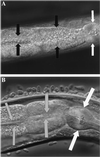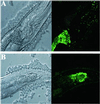Killing of Caenorhabditis elegans by Cryptococcus neoformans as a model of yeast pathogenesis
- PMID: 12438649
- PMCID: PMC137775
- DOI: 10.1073/pnas.232568599
Killing of Caenorhabditis elegans by Cryptococcus neoformans as a model of yeast pathogenesis
Abstract
We found that the well-studied nematode Caenorhabditis elegans can use various yeasts, including Cryptococcus laurentii and Cryptococcus kuetzingii, as a sole source of food, producing similar brood sizes compared with growth on its usual laboratory food source Escherichia coli OP50. C. elegans grown on these yeasts had a life span similar to (C. laurentii) or longer than (C. kuetzingii) those fed on E. coli. However, the human pathogenic yeast Cryptococcus neoformans killed C. elegans, and the C. neoformans polysaccharide capsule as well as several C. neoformans genes previously shown to be involved in mammalian virulence were also shown to play a role in C. elegans killing. These included genes associated with signal transduction pathways (GPA1, PKA1, PKR1, and RAS1), laccase production (LAC1), and the alpha mating type. C. neoformans adenine auxotrophs, which are less virulent in mammals, were also less virulent in C. elegans. These results support the model that mammalian pathogenesis of C. neoformans may be a consequence of adaptations that have evolved during the interaction of C. neoformans with environmental predators such as free-living nematodes and amoebae and suggest that C. elegans can be used as a simple model host in which C. neoformans pathogenesis can be readily studied.
Figures




References
Publication types
MeSH terms
Substances
LinkOut - more resources
Full Text Sources
Other Literature Sources

